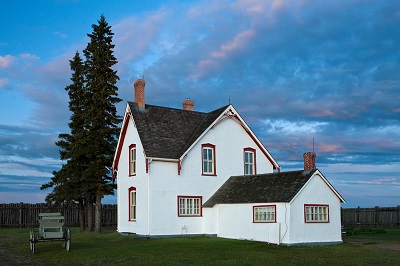Fort Battleford National Historic Site of Canada
Battleford, Saskatchewan

The Commanding Officer's house
© Parks Canada | Parcs Canada
Address :
Central Avenue, Battleford, Saskatchewan
Recognition Statute:
Historic Sites and Monuments Act (R.S.C., 1985, c. H-4)
Designation Date:
1923-05-25
Dates:
-
1876 to 1876
(Construction)
-
1876 to 1885
(Significant)
-
1876 to 1924
(Significant)
Event, Person, Organization:
-
Northwest Rebellion / Resistance of 1885
(Event)
-
Mistahimaskwa (Big Bear)
(Person)
-
Pitikwahanapiwiyin (Poundmaker)
(Person)
-
General Middleton
(Person)
-
North West Mounted Police
(Organization)
Other Name(s):
-
Fort Battleford
(Designation Name)
-
Northwest Rebellion
(Other Name)
Research Report Number:
1970-39; 1964-18
DFRP Number:
14256 00
Plaque(s)
Existing plaque: Central Avenue, Battleford, Saskatchewan
Here in July 1876, Superintendent James Walker established a post of the North-West Mounted Police in the heart of the Cree country. “The Fort” grew to a strength of 200. During the uprising of 1885 it gave refuge to more than 400 people and was the base for operations at Cut Knife Hill and Fort Pitt leading to the surrender of Chief Poundmaker and the search for Big Bear. With the extension of settlement and mechanization of the Force it ceased to be the barracks in 1924.
*Note: This designation has been identified for review. A review can be triggered for one of the following reasons - outdated language or terminology, absence of a significant layer of history, factual errors, controversial beliefs and behaviour, or significant new knowledge.
Description of Historic Place
Fort Battleford is an early North West Mounted Police post located on the edge of the town of Battleford at the junction of the Battle and North Saskatchewan rivers. The designation refers to the site and its historic resources, which extends in a diamond shape from the river terrace above the junction of the rivers. Built resources include several small wooden buildings within a stockade.
Heritage Value
Fort Battleford was designated a national historic site because of: the role of the North West Mounted Police at the fort from 1876 to 1885 in extending the Canadian government’s interests in the west; the role of the fort during the Northwest Rebellion / Resistance of 1885, including its role in the “seige” of Battleford, as a base for the military operations at Cut Knife Hill, Fort Pitt and the search for Mistahimaskwa (Big Bear), and as the site of the surrender of Pitikwahanapiwiyin (Poundmaker) to General Middleton’s forces on 26 May 1885.
The heritage value of Fort Battleford National Historic Site of Canada lies in its historical associations with the NWMP presence in what was then the North West Territories, 1876-1885, as illustrated by the site and its surviving resources. Fort Battleford was established by the North West Mounted Police in 1876 and closed in 1924. At the time it was built, Battleford was capital of Canada’s newly acquired North West Territories. The site is now operated by Parks Canada and is open to the public.
Sources: Historic Sites and Monuments Board of Canada, Minutes, 1953; Commemorative Integrity Statement, 1997.
Character-Defining Elements
Key features contributing to the heritage value of this site include:
the setting of the fort between two major water routes; the size and diamond shape of the fort’s grounds; the original spatial relationship of above and below-ground surviving buildings and remains; the buildings surviving from the 1876-1885 period (the Commanding Officer’s Residence, and the Officer’s Quarters) in their rectangular massing, pitched roofs, the regularly spaced apertures, local construction materials (plaster-coated wood walls, wood-shingle roofs), construction technology (Red River frame for the Commanding Officer’s Residence, log construction for officers’ quarters), surviving original interior layouts and finishes; the footprints, materials, and other archaeological remains of all structures no longer standing (including buildings, bastions, and other structures associated with the 1876-1885 period both inside and outside the stockade); the remains of earthen fortifications constructed adjacent to the stockade in 1885; vestiges of a network of historic trails around the fort; archaeological evidence of NWMP life and experience (both in ground and above), including those remains removed from the site and placed in storage by Parks Canada; viewscapes along both the Battle and North Saskatchewan rivers, across the Battle River to the former Government House, to the vestiges of historic trails that linked Fort Battleford to its outpost, to the historic townsite of Battleford, viewscape to the site from the former Government House.